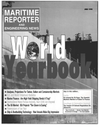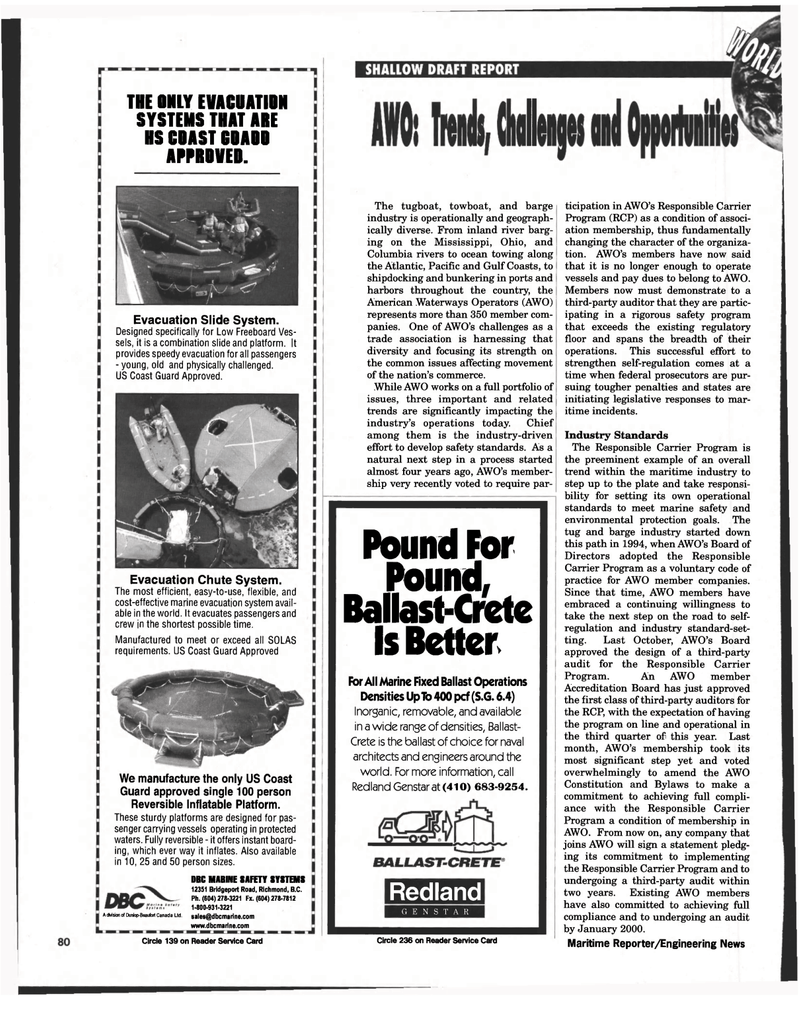
Page 63: of Maritime Reporter Magazine (June 1998)
Read this page in Pdf, Flash or Html5 edition of June 1998 Maritime Reporter Magazine
THE HUT EVACUATION
SYSTEMS THAT ARE
HS COAST GOAOO
APPROVED.
Evacuation Slide System.
Designed specifically for Low Freeboard Ves- sels, it is a combination slide and platform. It provides speedy evacuation for all passengers - young, old and physically challenged.
US Coast Guard Approved.
Evacuation Chute System.
The most efficient, easy-to-use, flexible, and cost-effective marine evacuation system avail- able in the world. It evacuates passengers and crew in the shortest possible time.
Manufactured to meet or exceed all SOLAS requirements. US Coast Guard Approved
We manufacture the only US Coast
Guard approved single 100 person
Reversible Inflatable Platform.
These sturdy platforms are designed for pas- senger carrying vessels operating in protected waters. Fully reversible - it offers instant board- ing, which ever way it inflates. Also available in 10, 25 and 50 person sizes.
DRC MARINE SAFETY SYSTEMS 12351 Bridgeport Road, Richmond, B.C.
Ph. (604) 278-3221 Fx. (604) 278-7812 1-800-931-3221 [email protected] www.dbcmarine.com
A dvision of Dunkjp-Beaufort Canada Ltd.
The tugboat, towboat, and barge industry is operationally and geograph- ically diverse. From inland river barg- ing on the Mississippi, Ohio, and
Columbia rivers to ocean towing along the Atlantic, Pacific and Gulf Coasts, to shipdocking and bunkering in ports and harbors throughout the country, the
American Waterways Operators (AWO) represents more than 350 member com- panies. One of AWO's challenges as a trade association is harnessing that diversity and focusing its strength on the common issues affecting movement of the nation's commerce.
While AWO works on a full portfolio of issues, three important and related trends are significantly impacting the industry's operations today. Chief among them is the industry-driven effort to develop safety standards. As a natural next step in a process started almost four years ago, AWO's member- ship very recently voted to require par-
Pound For Pound,
Ballast-Crete Is Better*
For All Marine Fixed Ballast Operations
Densities Up To 400 pcf (S.G. 6.4)
Inorganic, removable, and available in a wide range of densities, Ballast-
Crete is the ballast of choice for naval architects and engineers around the world. For more information, call
Redland Genstarat(4l0) 683-9254.
Redland
G E N S T A R
Circle 139 on Reader Service Card Circle 236 on Reader Service Card ticipation in AWO's Responsible Carrier
Program (RCP) as a condition of associ- ation membership, thus fundamentally changing the character of the organiza- tion. AWO's members have now said that it is no longer enough to operate vessels and pay dues to belong to AWO.
Members now must demonstrate to a third-party auditor that they are partic- ipating in a rigorous safety program that exceeds the existing regulatory floor and spans the breadth of their operations. This successful effort to strengthen self-regulation comes at a time when federal prosecutors are pur- suing tougher penalties and states are initiating legislative responses to mar- itime incidents.
Industry Standards
The Responsible Carrier Program is the preeminent example of an overall trend within the maritime industry to step up to the plate and take responsi- bility for setting its own operational standards to meet marine safety and environmental protection goals. The tug and barge industry started down this path in 1994, when AWO's Board of
Directors adopted the Responsible
Carrier Program as a voluntary code of practice for AWO member companies.
Since that time, AWO members have embraced a continuing willingness to take the next step on the road to self- regulation and industry standard-set- ting. Last October, AWO's Board approved the design of a third-party audit for the Responsible Carrier
Program. An AWO member
Accreditation Board has just approved the first class of third-party auditors for the RCP, with the expectation of having the program on line and operational in the third quarter of this year. Last month, AWO's membership took its most significant step yet and voted overwhelmingly to amend the AWO
Constitution and Bylaws to make a commitment to achieving full compli- ance with the Responsible Carrier
Program a condition of membership in
AWO. From now on, any company that joins AWO will sign a statement pledg- ing its commitment to implementing the Responsible Carrier Program and to undergoing a third-party audit within two years. Existing AWO members have also committed to achieving full compliance and to undergoing an audit by January 2000.
Maritime Reporter/Engineering News

 62
62

 64
64
